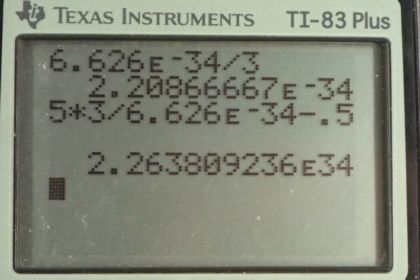Question
A physicist is watching a 15-kg orangutan at a zoo swing lazily in a tire at the end of a rope. He (the physicist) notices that each oscillation takes 3.00 s and hypothesizes that the energy is quantized. (a) What is the difference in energy in joules between allowed oscillator states? (b) What is the value of n for a state where the energy is 5.00 J? (c) Can the quantization be observed?
Final Answer
- No, this quantization can not be observed since is too small.
Solution video
OpenStax College Physics, Chapter 29, Problem 3 (Problems & Exercises)

vote with a rating of
votes with an average rating of
.
Calculator Screenshots
Video Transcript
This is College Physics Answers with Shaun Dychko. A physicist is watching an orangutan swing on a rope swing and that is a type of oscillation and these formulas do apply to it but we'll notice that our numbers become difficult to observe and so that's why quantization is not noticed in macroscopic phenomena. So the period of oscillation of this orangutan swing is 3 seconds and we'll first figure out first what is the difference in in energy between the neighboring states; that's going to be Planck's constant times the frequency of oscillation and the frequency is the reciprocal of the period. So we'll substitute 1 over T in place of f. So we have Planck's constant—6.626 times 10 to the minus 34 joule seconds— divided by 3 seconds giving us 2.21 times 10 to the minus 34 joules. That is an extremely small number that will never be observed. And part (b) says suppose the energy of its oscillation is 5 joules, what is the number, n, in this formula? So we have energy is n plus a half times Planck's constant times frequency and we multiply through by hf and we get nhf plus hf over 2, on one side, equals E, on the other side, also switching the sides around so that n is on the left. And then subtract hf over 2 from both sides and we get nhf equals E minus hf over 2 and then divide both sides by hf. And we have n equals energy over hf minus a half. And we'll substitute reciprocal of period in place of f and so that's where this T comes from here. So I substituted 1 over T for f here but having it in the denominator, well, if I replace that with 1 over T here then I can multiply top and bottom by T in order to have T in the numerator; that looks a bit cleaner. So n is energy times period over Planck's constant minus a half. So that's 5 joules times 3 seconds divided by Planck's constant minus a half giving us 2.26 times 10 to the 34 and that's a really large number. And so this quantization cannot be observed because the difference in energy states is too small.



